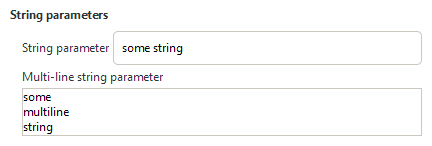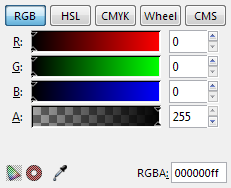|
|
| Line 22: |
Line 22: |
| Not used by the notebook parameter (you can set the attribute, but it doesn't show in the dialog). | | Not used by the notebook parameter (you can set the attribute, but it doesn't show in the dialog). |
|
| |
|
| ===gui-tip=== | | ===gui-description=== |
| Tooltip of the parameter. | | Tooltip of the parameter. |
|
| |
| Rarely used in the current extensions due to a crashing bug when used in a notebook.
| |
|
| |
|
| ===gui-hidden=== | | ===gui-hidden=== |
Revision as of 01:27, 22 November 2015
Here you will find the different parameter elements you may use in your .inx files (Inkscape Extensions)
Introduction
Use parameter elements to capture user input for further use by a script. The basic structure of the element is:
<param name="some_name" type="some_type">default value</param>
The default value is the value that is shown in the input control the first time the user opens the dialog window. Inkscape automatically displays the values used last time when the dialog window is opened again.
Common attributes
type
Gives the type of parameter (int|float|string|boolean|enum|notebook|description|optiongroup|color).
name
Identifier of the parameter.
gui-text
Label of the parameter.
Not used by the notebook parameter (you can set the attribute, but it doesn't show in the dialog).
gui-description
Tooltip of the parameter.
gui-hidden
If true, hide the parameter in the GUI (default to false).
Types
| Type
|
Code
|
Result
|
| string
|
A textbox to capture a character string.
<param name="some_name" type="string" _gui-text="Some text label">Some default text</param>
|

|
| int
|
To get a textbox for an integer number. Limit the input range with the min and max attributes. By default, min=0 and max=10.
<param name="some_name" type="int" min="1" max="100" _gui-text="Some label text">1</param>
|

|
| float
|
To get a textbox for a float number. Limit the input range with the min and max attributes. To set the number of decimal places, use the precision attribute. By default, min=0, max=10, and precision=1
<param name="some_name" type="float" precision="3" min="0" max="9999"
_gui-text="Some label text">1.234</param>
|

|
| boolean
|
Gives a checkbox. Set the default value to true or 1, false or 0.
<param name="some_name" type="boolean" _gui-text="Some label text">false</param>
|

|
| enum
|
Creates a list of choices where the user can only select one option using a drop down select list. Create the different choices with <item> elements. The first item is selected by default. The returned value for the optiongroup element is the value attribute of the selected item.
<param name="some_name" type="enum" _gui-text="Some label text">
<_item value="1">First option</_item>
<_item value="2">Second option</_item>
</param>
|

|
| optiongroup
|
Creates a list of choices where the user can only select one option. By default this is displayed as radiobuttons. Set the attribute appearance="minimal" to display a drop down select list instead. Create the different choices with <option> elements. The first option is selected by default. The returned value for the optiongroup element is the value attribute of the selected option.
<param name="some_name" type="optiongroup" appearance="minimal"
_gui-text="Some label text">
<_option value="1">First option</_option>
<_option value="2">Second option</_option>
</param>
|

|
| color
|
Creates a control to select a color. The returned value is a RGBA-value.
<param name="some_name" type="color"></param>
|

|
| description
|
To show some text in the dialog window, for example as "help" text.
<param name="some_name" type="description">Some text here.</param>
|

|
| notebook
|
Creates a set of pages or tab-sheets. Create individual pages with the <page> element. The returned value for the notebook parameter element is the name of the selected page/tab.
<param name="some_name" type="notebook">
<page name="name_page_1" _gui-text="First page">
<param>...</param>
</page>
<page name="name_page_2" _gui-text="Second page">
<param>...</param>
</page>
</param>
|

|



